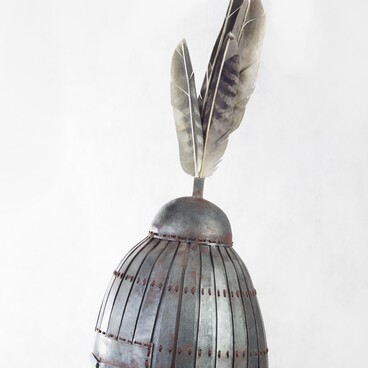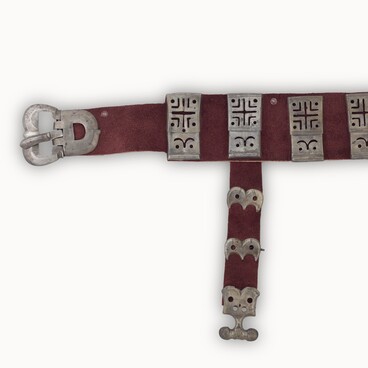The Kursk Regional Museum of Archaeology displays a small weight from the late 10th — mid–11th century, which was used for weighing.
In 2000, the Gochevskaya Ancient Russian Expedition led by the archaeologist Gennady Yurievich Starodubtsev conducted rescue excavations on the territory of the Lyushinsky ancient settlement in the Kursk region. Moreover, a walking survey of the archaeological monument was carried out near the sand pit mound, where various artefactual remains were collected. A small scale weight was also among them.
The find, registered beyond the archaeology deposit, was a small spherical metal piece with parallel truncated “poles”. On each plane is a drawing in the form of three punched circles. Punching technique ornamentation is a particular way of applying ornaments with a punch, a special tool for stamping. Connecting arc-shaped lines in the form of three S, each ending in small circles, run from the circles to the center of the plane. Also, along the perimeter of the planes a punched ornament is clearly visible. The weight was made of iron and then covered with a copper shell, on which the ornament was applied.
The available analogues come from the research material of Birka (Sweden) and Suprutsky sites (Tula region). Scale weights and, thus, the scales themselves were widely used in the territory of Old Russia. They were part of the toolkit, which was used in small trading operations with silver coins — dirhams.
There are still debates among specialists as to which region such measuring instruments originated from. One version says that the first weights and scales came from Scandinavia. The evidence cites the finds from Sweden and Kiev, where the mass of the weights was identical. According to another version, the tradition of weighing came from the East, where the flow of silver coins passed through the territory of Volga Bulgaria and Khazar Khaganate to Old Russia.
As of today, five more finds of scale weights are registered on the territory of the modern Kursk region. Some of them are presented in the main exhibition of the Kursk Regional Museum of Archeology.
In 2000, the Gochevskaya Ancient Russian Expedition led by the archaeologist Gennady Yurievich Starodubtsev conducted rescue excavations on the territory of the Lyushinsky ancient settlement in the Kursk region. Moreover, a walking survey of the archaeological monument was carried out near the sand pit mound, where various artefactual remains were collected. A small scale weight was also among them.
The find, registered beyond the archaeology deposit, was a small spherical metal piece with parallel truncated “poles”. On each plane is a drawing in the form of three punched circles. Punching technique ornamentation is a particular way of applying ornaments with a punch, a special tool for stamping. Connecting arc-shaped lines in the form of three S, each ending in small circles, run from the circles to the center of the plane. Also, along the perimeter of the planes a punched ornament is clearly visible. The weight was made of iron and then covered with a copper shell, on which the ornament was applied.
The available analogues come from the research material of Birka (Sweden) and Suprutsky sites (Tula region). Scale weights and, thus, the scales themselves were widely used in the territory of Old Russia. They were part of the toolkit, which was used in small trading operations with silver coins — dirhams.
There are still debates among specialists as to which region such measuring instruments originated from. One version says that the first weights and scales came from Scandinavia. The evidence cites the finds from Sweden and Kiev, where the mass of the weights was identical. According to another version, the tradition of weighing came from the East, where the flow of silver coins passed through the territory of Volga Bulgaria and Khazar Khaganate to Old Russia.
As of today, five more finds of scale weights are registered on the territory of the modern Kursk region. Some of them are presented in the main exhibition of the Kursk Regional Museum of Archeology.



